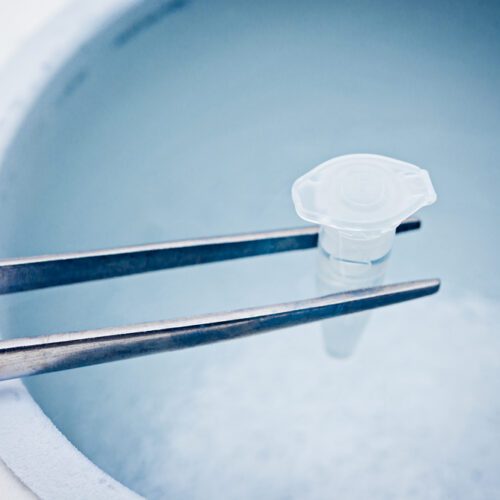Frozen Embryo Transfer: How Does It Differ From Fresh Transfer?
You’re going to face a lot of decisions along your fertility journey. In particular, choosing whether to do a fresh or frozen embryo transfer will determine your approach to IVF treatment. Good decision-making involves being educated about your body, the IVF process, and your clinic or treatment program. To help you anticipate the decisions that may come your way, we’re going to discuss the two methods of embryo transfer used with IVF, how they differ, and when each is likely to be recommended.
What is in vitro fertilization (IVF)?
In vitro fertilization (IVF) is the prevailing form of assisted reproductive technology (ART) that involves retrieving viable eggs, fertilizing them in a lab setting, and then transferring them into the uterus where they will hopefully implant and result in pregnancy.
The process begins with a course of injectable ovary-stimulating medications to help you produce multiple eggs in one menstrual cycle. These medications are taken for 8 to 12 days, with blood work to monitor how your body is responding to the hormone medications and ultrasounds to help determine the size of the follicles as they develop.
Once the eggs are mature, typically on day 11 or 12 of your treatment protocol, there is an outpatient surgical procedure to retrieve them. At this point, the male partner or donor provides a semen sample, which will be combined with the retrieved eggs. The resulting fertilized eggs will be watched by an embryologist for up to five days.
Typically, the developed embryos are then transferred into the uterus. However, the embryos can be safely frozen for future use if now is not the right time to start having kids.
What is a frozen embryo transfer?
Like the standard IVF treatment cycle, a frozen embryo transfer is a process during which an embryo or multiple embryos that have been fertilized and developed in a lab are transferred into your uterus during your window of implantation (WOI). However, with FET you won’t have to undergo egg retrieval just before the embryo transfer because the embryo(s) used will have been cryopreserved and will be thawed shortly before your transfer procedure.
The transfer process is identical to that of a fresh embryo transfer. During the procedure, you may be given a mild sedative. Your fertility specialist will insert a long, thin catheter into your vagina, through your cervix, and into your uterus. They will then use a syringe containing your embryo or embryos suspended in a small amount of liquid to place them into your uterus. Embryo implantation typically occurs within five days of this procedure.
How does a frozen embryo transfer differ from a fresh embryo transfer?
As the name implies, frozen embryo transfers use embryos that have been cryopreserved, or frozen, after a pervious egg retrieval cycle. This allows you to undergo IVF treatment without an additional egg-retrieval process.
By contrast, a fresh embryo transfer must occur within three to five days after the egg retrieval. Waiting any longer means that the embryos will develop past the blastocyst stage and become unviable for transfer. Typically, the first IVF treatment cycle will be a fresh embryo transfer, unless you already have frozen eggs or you’re using donated eggs or embryos.
In both cases, the actual transfer procedure is identical. The big difference is in the weeks that lead up to the procedure. With a fresh embryo transfer, the emphasis is on stimulating the ovaries to produce multiple mature eggs in one menstrual cycle. Whereas, with a frozen embryo transfer, the focus is on preparing your uterine lining to be receptive to embryo implantation.
Why do parents choose IVF with frozen embryo transfer?
The biggest benefit to doing IVF with frozen embryo transfer is that you have much more control over when to schedule the transfer procedure. This is because cryopreserving embryos halts their development in their tracks. Without the pressure of implanting your embryos while they’re still viable, you can focus on ensuring all the conditions are just right for embryo implantation. Below are some of the common reasons parents opt for IVF with frozen embryo transfer.
You have extra embryos from a previous IVF cycle
As mentioned earlier, the first cycle of IVF is frequently a fresh embryo transfer. As is often the case, parents will have more viable embryos than they choose to implant. These embryos will be frozen so that they can be used in future treatment cycles, whether because their first cycle didn’t result in pregnancy or because they wish to have more children down the line.
You’ve opted for preimplantation genetic testing (PGT)
Preimplantation genetic testing (PGT) is one of the big advancements in assisted reproductive technology. There are three types of PGT, and each is useful for evaluating the genetic health of your embryos. However, to undergo this kind of testing, your embryos have to be frozen, which means having a frozen embryo transfer.
Your fresh embryo transfer was canceled
There are a number of reasons that your fresh embryo transfer is canceled. A common reason is that the uterine environment is not where it needs to be to support embryo implantation. There are other reasons, like catching a cold or getting sick in the days between egg retrieval and transfer.
You’re using donor embryos
Not every parent is able to produce their own embryos. It could be because you’re in a same sex relationship or have an underlying medical condition that makes it more difficult to produce the necessary eggs or sperm. Whatever your reason for using donor embryos may be, typically this will involves IVF with frozen embryo transfer.
You froze your eggs when you were younger
Egg freezing used to be an experimental procedure mostly recommended for people who needed life-saving medical treatment for conditions like cancer, or who were about to undergo gender affirming treatment. Now, it is much more widely available, and has gotten more attention after companies like Google and Meta began offering coverage for the procedure as part of their fertility benefits.
Medicated vs. Unmedicated frozen embryo transfers
There are two ways to prepare for a frozen embryo transfer. The medicated method involves taking estrogen for the first 14 or so days of your menstrual cycle. Once your endometrium is found to be thick enough with an ultrasound, you’ll take progesterone until your WOI. However, not everyone needs the added support of fertility medication to reach adequate endometrial thickness for embryo implantation. This means that it is possible to have a frozen embryo transfer without taking any medication at all.
In some cases, women will be prescribed oral fertility medications, which have a lower level of hormones than the injectable fertility medications.
Are IVF success rates better with frozen embryo transfer?
The data suggests that yes, IVF success rates are better with frozen embryo transfers. There are several factors that could contribute to this. It’s been theorized that the egg-retrieval process, which requires an intensive regimen of hormone medication can impact your ability to create the ideal uterine conditions for embryo implantation. By waiting another cycle, your body will have time to rest and reset, which can help prepare your endometrium for embryo implantation.
Another factor is that having preimplantation genetic testing done will identify chromosomal abnormalities known to result in implantation failure or miscarriage. By removing these embryos from your reserve of viable embryos, you can increase your chances of getting pregnant from IVF by 15-20%.



